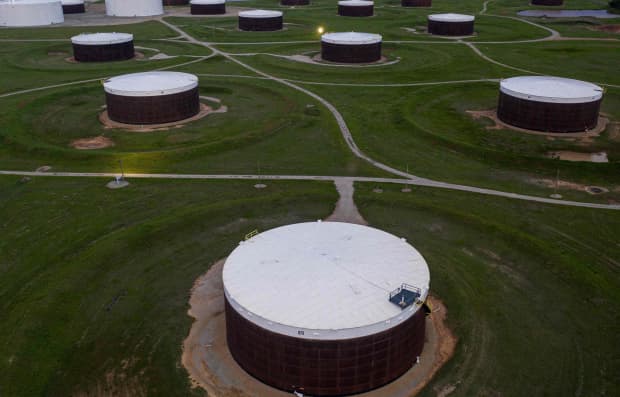This post was originally published on this site

Storage data is on tap Thursday.
Johannes Eisele/Agence France-Presse/Getty Images
Oil futures settled a bit lower Thursday as rising COVID-19 infections led to renewed restrictions on movement in several European countries, raising concerns over a further slowdown in energy demand.
Prices, however, nearly erased their losses for the session after U.S. government data showed a better-than-expected weekly decline in domestic crude supplies.
“COVID-19 reports will continue to rule the daily volatility,” said James Williams, energy economist at WTRG Economics.
However, “in the longer term, there is a lot of upward pressure building,” as prices are not high enough to “encourage sufficient drilling to offset U.S. production declines,” he told MarketWatch, adding that demand will likely recover faster than U.S. output.
West Texas Intermediate crude for November delivery CL.1, -0.09% fell 8 cents or 0.2%, to settle at $40.96 a barrel on the New York Mercantile Exchange. It was trading at $39.75 shortly before the supply data.
The global benchmark, December Brent crude BRN00, +0.04% shed 16 cents, or 0.4%, to $43.16 a barrel on ICE Futures Europe.
Households in London will be banned from mixing indoors with other households beginning Saturday, joining a number of European cities that have tightened restrictions in an effort to contain a resurgence of the spread of COVID-19. Germany has put new limits on gatherings, while nighttime curfews are being implemented in nine French cities.
“This is still an environment that’s very unfavorable for oil prices, and with increasing restrictions being imposed across Europe and probably following shortly after across the pond, the demand picture is not looking great,” said Craig Erlam, senior market analyst at Oanda, in a note.
“I struggle to see oil managing to hold on at these levels unless a stimulus package in the U.S. is somehow struck ahead of the election,” he said. “Even then, the risks remain tilted to the downside medium term, barring another OPEC+ intervention.”
Prices significantly pared their losses Thursday after data showed a bigger-than-expected fall in U.S. crude inventories last week.
The Energy Information Administration reported Thursday that U.S. crude inventories fell by 3.8 million barrels for the week ended Oct. 9. The data, which was delayed by a day because of Monday’s U.S. federal holiday, followed a 500,000-barrel increase in the previous week.
On average, analysts polled by S&P Global Platts forecast a weekly decline of 2.3 million barrels, while the American Petroleum Institute on Wednesday reported a decrease of 5.4 million barrels.
“A big drop in both production and imports as a result of Hurricane Delta last week has resulted in a decent draw to oil inventories–despite ongoing barrels being shifted from the [Strategic Petroleum Reserve] into commercial inventories,” said Matt Smith, director of commodity research at ClipperData. “The storm also hampered oil exports, while refining activity dipped, but that was likely more related to maintenance and adverse economics than tropical activity.”
The EIA data also showed crude stocks at the Cushing, Okla., storage hub edged up by 2.9 million barrels for the week.
Gasoline supply, meanwhile, declined by 1.6 million barrels, while distillate stockpiles fell by 7.2 million barrels. The S&P Global Platts survey had shown expectations for supply declines of 1.8 million barrels for gasoline and 2.5 million barrels for distillates.
“A pop in implied demand for distillates has encouraged a whopping draw to inventories, while lower implied gasoline demand brought a less[er] draw on that front,” said Smith, in emailed commentary.
Among the products, November gasoline RBX20, -1.22% fell by 1.4% to $1.18 a gallon and November heating oil HOX20, -0.30% lost 0.3% to $1.1887 a gallon.
Oil finished higher on Wednesday after the official Saudi Press Agency said Saudi Arabia’s Crown Prince Mohammed bin Salman and Russian President Vladimir Putin, in a phone call, “agreed on the importance of all oil-producing countries to continue cooperating and abiding by OPEC+ agreement to achieve these goals for the benefit of both producers and consumers.”
OPEC Secretary-General Mohammad Barkindo on Thursday echoed that message, saying that OPEC+ would move to ensure oil prices don’t fall sharply when it meets late next month, Reuters reported.
Barkindo acknowledged a slower-than-expected rebound in oil demand.
“We have to be realistic that this recovery is not picking up pace at the rate we expected earlier in the year,” he said, according to the report. “Demand itself is still looking anemic.”
The Joint OPEC-Non-OPEC Ministerial Monitoring Committee, or JMMC, which monitors compliance with production cuts, is scheduled to meet on Monday. OPEC+ is scheduled to hold official meetings on Nov. 30 and Dec. 1.
Meanwhile, natural-gas futures bucked the trend among its energy peers, to finish sharply higher after the EIA on Thursday reported that domestic supplies of natural gas rose by 46 billion cubic feet for the week ended Oct. 9.
Supplies were expected to climb by 60 billion cubic feet for the week, according to an estimate from Marshall Steeves, energy markets analyst at IHS Markit.
November natural gas NGX20, +5.38% rose 14 cents, or 5.3%, to $2.775 per million British thermal units.

